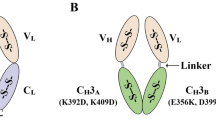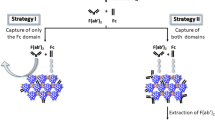Abstract
Cytoplasmatic expression of murine antibody chains in Escherichia coli results in the formation of insoluble and inactive protein aggregates (inclusion bodies). By systematic variation of the parameters influencing the folding, formation of disul-fide bonds and association of the constituent polypeptide chains, we have designed a renaturation procedure allowing the production of microbially expressed Fab-fragments at yields up to 40 percent of the total amount of recombinant protein. The strategy of optimization is generally applicable for disulnde containing proteins produced as inclusion bodies in bacteria. The purified recombinant antibody fragments obtained are identical with the native murine Fab in all functional and phys-icochemical parameters tested.
This is a preview of subscription content, access via your institution
Access options
Subscribe to this journal
Receive 12 print issues and online access
$209.00 per year
only $17.42 per issue
Buy this article
- Purchase on Springer Link
- Instant access to full article PDF
Prices may be subject to local taxes which are calculated during checkout
Similar content being viewed by others
References
Marston, F.A.O. 1986. The purification of eukaryotic polypeptides synthesized in Escherichia coli. Biochem. J. 240: 1–12.
Boss, M.A., Kenten, J.H., Woo, C.R. and Emtage, J.S. 1984. Assembly for functional antibodies from immunoglobulin heavy and light chains synthesised in E. coli. Nucleic Acids Res. 12: 3791–3806.
Cabilly, S., Riggs, A.D., Pande, H., Shively, J.E., Holmes, W.E., Rey, M., Perry, L.J., Wetzel, R. and Heyneker, H.L. 1984. Generation of antibody activity from immunoglobulin chains produced in Escherichia coli. Proc. Natl. Acad. Sci. U.S.A. 81: 3273–3277.
Plückthun, A., Glockshuber, R., Pfitzinger, I., Skerra, A. and Stadl-müller, J. 1987. Engineering of antibodies with a known three-dimensional structure. Cold Spring Harbor Symp. Quant. Biol. 52: 105–112.
Bird, R.E., Hardman, K.D., Jacobson, J.W., Johnson, S., Kaufman, B.M., Lee, S.-M., Lee, T., Pope, S.H., Riordan, G. and Whitlow, M. 1988. Single-chain antigen-binding proteins. Science 242: 423–426.
Field, H., Yarranton, G.T. and Rees, A.R. 1988. A functional recombinant immunoglobulin variable domain from polypeptides produced in Escherichia coli, p. 29–34. In: Ginsberg, H., Brown, F., Lerner, R. A., and Chanock, R. M. (Eds.). Vaccines 88, Cold Spring Harbor, NY.
Huston, J.S., Levinson, D., Mudget-Hunter, M., Tai, M.-S., No-votny, J., Margolies, M.N., Ridge, R.J., Bruccoleri, R.E., Haber, E., Crea, R. and Oppermann, H. 1988. Protein engineering of antibody binding sites: Recovery of specific activity in an anti-digoxin single-chain Fv analogue produced in Escherichia coli. Proc. Natl. Acad. Sci. U.S.A. 85: 5879–5883.
Condra, J.H., Sardana, V.V., Tomassini, J.E., Schlabach, A.J., Davies, M.-E., Lineberger, D.W., Graham, D.J., Gotlib, L. and Colonno, R.J. 1990. Bacterial expression of antibody fragments thai block human rhinovirus infection in cultured cells. J. Biol. Chem. 265: 2292–2295.
Buckel, P., Hübner-Parajsz, C., Mattes, R., Lenz, H., Haug, H. and Beaucamp, K. 1987. Cloning and nucleotide sequence of heavy- and light-chain cDNAs from a creatine-kinase-specific monoclonal antibody. Gene 51: 13–19.
Jaenicke, R. 1987. Folding and association of proteins. Prog. Bio-phys. Mol. Biol. 49: 117–237.
Pelham, H.R.B. 1989. Control of protein exit from the endoplas-matic reticulum. Ann. Rev. Cell Biol. 5 1–23.
Jaenicke, R. and Rudolph, R. 1989. Folding proteins, p. 191–223. In: Protein Structure, a Practical Approach. Creighton, T. E. (Ed.). IRL Press, Oxford.
Rudolph, R. 1990. Renaturation of recombinant, disulfide-bonded proteins from “inclusion bodies”, p. 149–171. In: Modern Methods in Protein and Nucleic Acid Analysis. Tschesche, H. (Ed.) Walter de Gruyter, Berlin, New York.
Buchner, J., Jaenicke, R. and Rudolph, R. 1990. In preparation.
Saxena, V.P. and Wetlaufer, D.B. 1970. Formation of three-dimensional structure in proteins. I. Rapid nonenzymatic reactivation of reduced lysozyme. Biochemistry 9: 5015–5021.
Rudolph, R., Buchner, J. and Lenz, H. 1990. Aktivierung von gentechnologisch hergestellten, in Prokaryonten exprimierten Antikörpern. Eur. Patent Application 0364926.
Odorzynski, T.W. and Light, A. 1979. Refolding of the mixed disulfide of bovine trypsinogen and gluthathione. J. Biol. Chem. 254: 4291–4295.
Orsini, G. and Goldeberg, M.E. 1978. The renaturation of reduced chymotrypsinogen A in guanidine HCl: Refolding versus aggregation. J. Biol. Chem. 253: 3453–3458.
Rudolph, R., Fischer, S. and Mattes, R. 1987. Process for the activating of gene-technologically produced, heterologous, disulfide bridge-containing eucaryotic proteins after expression in procary-otes. International Patent Application WO 87/02673.
Zettlmeißl, G., Rudolph, R. and Jaenicke, R. 1979. Reconstitution of lactic dehydrogenase: noncovalent aggregation vs. reactivation. 1. Physical properties and kinetics of aggregation. Biochemistry 18: 5567–5571.
Goldberg, M., Rudolph, R. and Jaenicke, R. 1990. A kinetic study of the competition between renaturation and aggregation during the refolding of denatured-reduced egg-white lysozyme. Biochemistry. In press.
Rudolph, R., Kiefhaber, T., Kohler, H.-H. and Buchner, J. 1990. Formation of protein inclusion bodies: Kinetic competition between folding and aggregation. Submitted.
Zettlmeissl, G., Rudolph, R. and Jaenicke, R. 1982. The yield of reactivation of lactic dehydrogenase after guanidine·HCl denatur-ation is not determined by proline cis-trans isomerization. Eur. J. Biochem. 125: 605–608.
Viitanen, P.V., Lubben, T.H., Reed, J., Goloubinoff, P., O'Keefe, D. and Lorimer, G.H. 1990. Chaperonin-facilitated refolding of ribulosebisphosphate carboxylase and ATP hydrolysis of chaperonin 60 groEL are K+ dependent. Biochemistry 29: 5665–5671.
Goto, Y. and Hamaguchi, K. 1981. Formation of the intrachain disulfide bond in the constant fragment of the immunoglobulin light chain. J. Mol. Biol. 146: 321–340.
Parente, A. and D'Alessio, G. 1985. Reacquisition of quarternary structure by fully reduced and denatured seminal ribonuclease. Eur. J. Biochem. 149: 381–387.
Mayforth, R.D. and Quintans, J. 1990. Designer and catalytic antibodies. New England J. Med. 323: 173–178.
Wetzel, R. 1988. Active immunoglobulin fragments synthesized in E. coli-from Fab to Scantibodies. Protein Engineering 2: 169–170.
Glockshuber, R. and Plückthun, A. 1990. A comparison of strategies to stabilize immunoglobulin Fv-fragments. Biochemistry 29: 1362–1367.
Lemke, G., Lamar, E. and Patterson, J. 1988. Isolation and analysis of the gene encoding peripheral myelin protein zero. Neuron 1: 73–83.
Schneider-Schaulies, J., von Brunn, A., Schachner, M. 1990. Recombinant peripheral myelin protein po conferes both the adhesion and neural outgrowth promoting function. J. Neuroscience Research. 27: 286–297.
Buecheler, U. 1988. Expression von Fd-Fragment des monoklonalen Antikörpers MAK33 in E. coli. Thesis, Universität Stuttgart.
Bradford, M.M. 1975. A rapid and sensitive method for the quantitation of microgram quantities of protein utilizing the principle of protein-dye binding. Anal. Biochem. 72: 241–245.
Müller-Esterl, W. 1986. Practical considerations in enzyme-immuno-assays illustrated by a model system, p. 15–37. In: Methods of Enzymatic Analysis, 3rd Edition, Bergmeyer, H. U. (Ed.). Verlag Chemie, Weinheim.
Bergmeyer, H.U. 1974. Glutathion-reductase, p. 494–495. In: Methoden der Enzymatischen Analyse, Verlag Chemie, Weinheim.
Laemmli, U.K. 1970. Clevage of structural proteins during the assembly of the head of bacteriophage T4. Nature 227: 680–683.
Author information
Authors and Affiliations
Rights and permissions
About this article
Cite this article
Buchner, J., Rudolph, R. Renaturation, Purification and Characterization of Recombinant Fab-Fragments Produced in Escherichia coli. Nat Biotechnol 9, 157–162 (1991). https://doi.org/10.1038/nbt0291-157
Received:
Accepted:
Issue Date:
DOI: https://doi.org/10.1038/nbt0291-157
This article is cited by
-
Heavy chain dimers stabilized by disulfide bonds are required to promote in vitro assembly of trastuzumab
BMC Molecular and Cell Biology (2020)
-
A Systematic Protein Refolding Screen Method using the DGR Approach Reveals that Time and Secondary TSA are Essential Variables
Scientific Reports (2017)
-
Structural basis to stabilize the domain motion of BARD1-ARD BRCT by CstF50
Scientific Reports (2017)
-
Thermodynamic and Fluorescence Analyses to Determine Mechanisms of IgG1 Stabilization and Destabilization by Arginine
Pharmaceutical Research (2014)
-
Engineering and refolding of a novel trimeric fusion protein TRAIL-collagen XVIII NC1
Applied Microbiology and Biotechnology (2013)



